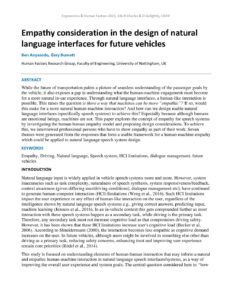| Document | Author Ben Anyasodo and Gary Burnett |
| Abstract While the future of transportation paints a picture of seamless understanding of the passenger goals by the vehicle, it also exposes a gap in understanding what the human-machine engagement must become for a more natural in-car experience. Through natural language interfaces, a human-like interaction is possible. This raises the question is there a way that machines can be more “empathic”? If so, would this make for a more natural human-machine interaction? And how can we design usable natural language interfaces (specifically speech systems) to achieve this? Especially because although humans are emotional beings, machines are not. This paper explores the concept of empathy for speech systems by investigating the human-human empathy model and proposing design considerations. To achieve this, we interviewed professional persons who have to show empathy as part of their work. Seven themes were generated from the responses that form a usable framework for a human-machine empathy which could be applied to natural language speech system design. |

